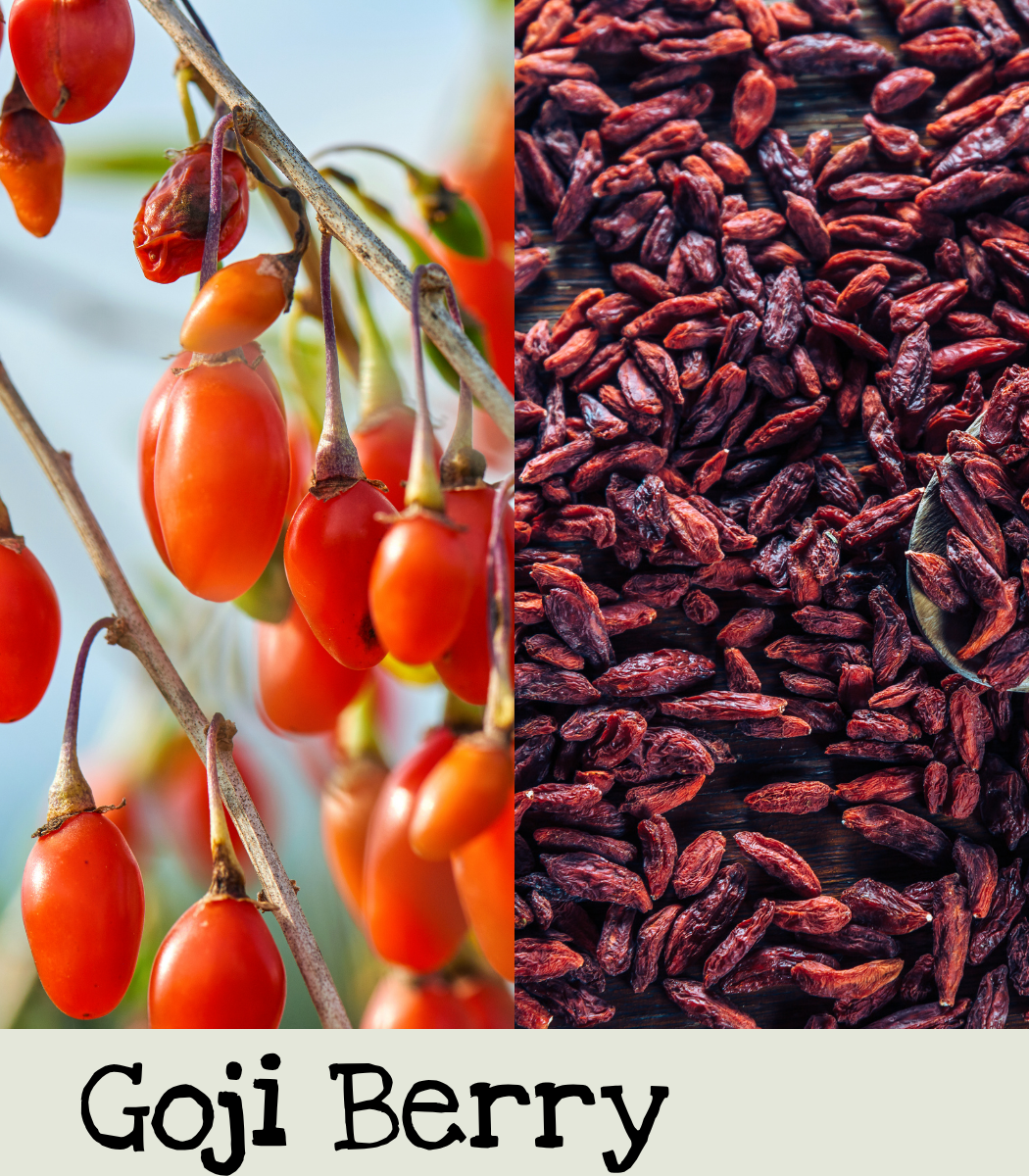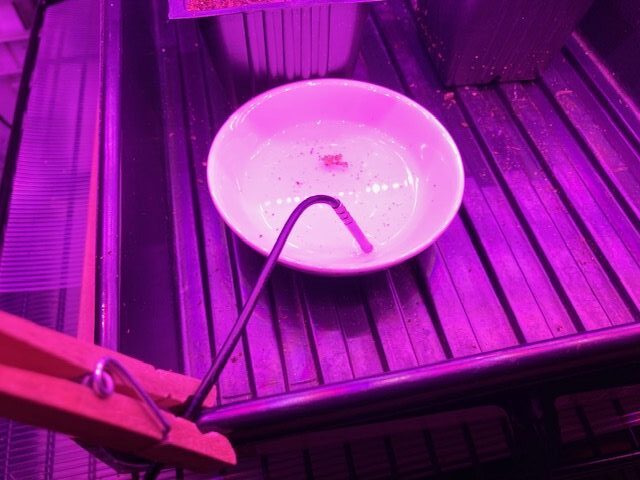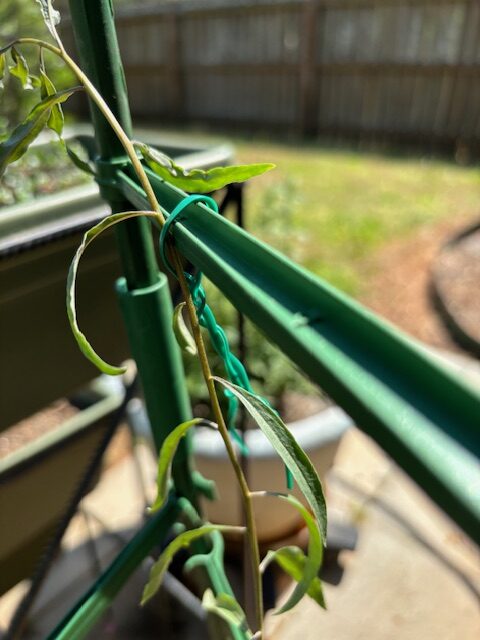
Goji Berry
Also known as Chinese wolfberry, the goji berry is a relatively new shrub in the US. These berries are considered a superfood. With a little patience and a bit of knowledge, these shrubs are easy to grow once established!
|
Scarlet |
|
Lycium barbarum |
|
Difficult to start from seed. Easy to grow once established. |
|
Intermediate to Easy |
|
Up to 3 years if properly stored (best guess) |
|
Perennial Shrub |
|
10-14 days |
|
Soak overnight in water that is consitantly 75-85°F |
|
1/4 inch |
|
Controlled by pruning |
|
Full sun for best berries |
|
2-3 years |
|
February, March |
|
Yes |

Growing Tips



1 plant per deep, large container
How to start
Direct sow: Not recommended.
Transplant: After the plant is one year old and the danger of frost has passed.
Goji is difficult to start from seed but easy to grow once established. Also called Chinese wolfberry, goji is a perennial shrub. Starting seedlings indoors is strongly recommended. According to Eden Brothers, “it is usually inefficient to start Goji outdoors, as healthy seedlings are a must and therefore a greater control over the germinating process is vital.” Soak seeds overnight in warm water (75-85 F) and then sow to a depth of 1/4 inch into seed cells.

Tip: Once the water was at the right temperature, I placed the container with the seeds and water on a tray with my heat mat underneath. This kept the water at a constant temperature throughout the 24-hour soaking period. After sowing, I kept them on a heat mat until germination. For safety, I made sure only the metal portion of the wire was in the water. I used a clothespin to keep the wire in place, making sure the wire wasn’t pinched–just loosely, snug.
Place the container with the seeds under grow lights. Goji seedlings are very susceptible to dampening off. Maintain good airflow, and strong light, and refrain from over-watering while starting from seed.
While some websites state you can transplant seedlings after the danger of frost has passed, it is STRONGLY recommended to keep the goji seedling as a houseplant for one year. Extension agencies across the country who have done research into the best methods of how to grow goji recommend growing the seedlings in a nursery (under grow lights for a home gardener) for one year before transplanting. Then after one year, harden it off and transplant the goji after the danger of frost has passed.
My personal experience
This is my personal experience when trying to grow goji as a seedling for a year. Since it was supposed to be difficult to grow from seed. I started 12 cells. They all germinated. They grew far more quickly than I expected and they grew taller than I had space. Since my space for growing plants indoors is limited, I hardened one off and transplanted it outside into a very large container. This was harder on the plant as it was the middle of summer and not early spring. The rest of the seedlings I took to the library as there is more space for plants with the setup there.
However, they were such happy plants and they quickly outgrew the space at the library. I tried tipping them to force them to grow more lateral branches and reduce the height. But even still they just kept growing! The seed library members got some free seedlings as a result.
The one I transplanted outdoors, had a bit of a hard time. It was also tipped, to encourage it to grow branches. It lost all its leaves and I thought it had died. But, it started putting on new growth. Based on my experience, I would recommend starting the goji berry soon enough that it can be hardened off and transplanted outside the same spring it was started. If you have the space to grow a small “tree” in the house then you should be able to keep it inside for one year.
Transplant the year-old seedlings into well-draining, alkaline soil. Add sand if needed to create better-draining soil. Space plants 3-4’ apart in full sun beds and 6-8 feet between rows. Use a trellis for easier harvesting. See Care and Harvesting for more details.
Container planting
Even though this is a shrub, you can grow goji in a container. As they have a long tap root, the minimum size container that should be used is 5 gallons, a much larger would be better. A trellis is still helpful for harvesting even with a container. When grown in a container, the goji will be more compact and will need more pruning and shaping. That being said, with goji being relatively new to the U.S. not a lot of research has been done about growing goji in a container. You may find that it outgrows its pot quickly and might do better being planted in the ground. According to Gardening Know How, “the plant will stop growing when the roots reach the bottom of the container, so a large and deep container is the way to go if you want a good-sized plant. Even with a large container, your goji berry plant will likely be smaller than in-ground plants.”
My Goji Berry
When my seedling was one year old, I hardened it off and transplanted it into a pot that holds 2 cubic feet of dirt. I felt like it needed some support so I used a regular tomato cage. I also wanted to make it easier on myself for harvesting.
Whenever you tie up branches, you want them to be loose enough not to cut off circulation and so they can still blow around in the wind. They need to be able to move just a little bit so that the branches can get strong and be able to support their own weight.
So far, the tomato cage is working just fine. I’ll see if it continues to work as the shrub grows.

Care:
It is important to plant in full sun beds for proper fruit setting. Goji is also sensitive to fertilizer and suffers if too much is applied. It can be difficult to grow in clay, but not impossible. Goji doesn’t like acidic, water-logged soil. Mix organic matter into clay soil to create more loamy soil.
Trellises make harvesting easier but are not necessary for support. Irrigation is highly recommended especially during the establishment year, as the root system is fine and can easily dry out, and the fruit is prone to blossom-end-rot under conditions of low or uneven moisture.1 Goji dislikes soggy soil, so only water when the soil is dry. See tips and tricks below for more watering information. If you live in an area where it gets over 100 F in the summer, some afternoon shade is helpful.
Goji is a member of the solanaceous (tomato or nightshade) plant family, so its cultural and nutritional needs are similar. Follow the watering methods and blossom-end-rot prevention found in 12 Tomato Planting Hacks. Mature plants have thorns, so gloves are recommended. Some commercial growers train goji like you would blackberries and raspberries. Training 2 canes on a trellis and encouraging branching. Birds can be a problem, so netting may be required. Once established goji is frost-hardy and drought-tolerant.
Harvesting:
When starting from seed it will take 2 years before the shrub will produce berries. Maximum berry production will occur within 3-5 years. These goji produce flowers and bright red fruit during the summer and continue producing until frost. Pick by hand when the berries are bright red and sweet. The berries should detach easily when ripe. Pull the berries slightly to the side instead of straight up. This will reduce the amount of stem that detaches. The berries will leak juice and turn black if they are bruised. Eat fresh berries within 2 weeks or dry them for longer storage. Depending on the variety, expect to harvest 2 to 6 pounds per plant. Leaves can also be harvested throughout the year to consume fresh or dried or used to make tea.
Storage:
They can be dried, juiced, frozen, or eaten fresh. Goji can be eaten alone or used in baking. They can be dried by laying the fruit out on drying trays in the sun, or in a food dehydrator (set the temperature to 105 F) for about 3 days. Berries can be frozen and they thaw well, maintaining their color and flavor.1
How to Prune:
Goji can grow 13-14 feet if not pruned. Fruit is borne on the current year’s wood, mainly from that which is grown in the spring and fall. The goals of pruning are to limit plant height, improve ease of harvest, encourage light penetration into the plant, improve foliage drying, and encourage the formation of lateral branches to maximize fruit production. Canes that are untipped will continue to grow and produce few lateral branches while canes that are headed back will produce more laterals and higher yields.
Little research has been conducted to determine the best pruning methods for our region. However, in other production areas, plants usually are limited to one single main stem. Pruning is done during the dormant season to remove spindly canes, remove dead and damaged wood, improve plant shape, and shorten laterals. During the summer, pruning is done to head back growth, encourage lateral formation, and remove new shoots. One of the most important goals of pruning is to produce an open canopy structure that allows plenty of sunlight infiltration.
The specifics of pruning
During the dormant season: Remove any weak, damaged, or crossing branches. Also trim lateral branches 6-18 inches, cutting back from the tip.1
During the growing season: Limit the height of the plant to keep it manageable, especially if the goji is in a container. To limit the height pinch the top 2-3 inches of the terminal growth in early summer. This is called tipping. Tipping will encourage the plant to produce more lateral branches which will, in turn, produce more fruit.1
Plants will send out new shoots after a few years. These shoots if left alone can cause the plant to grow out of control. Dig up or cut new shoots for transplant or discard.
Seed Saving


Instructions
Self-pollinating, goji berry can be propagated by seeds and by cuttings. Let the berries dry on the plant or crush the berries and spread out the seeds to dry. Dry seeds for a few days and store them in a cool dry place.
Goji cuttings can be taken from new growth in early summer or dormant cuttings in the winter. New growth is easier to root. Cuttings should be 4-6 inches long with at least 3 sets of leaves. Take the cuttings early in the morning as the moisture content is highest in the morning. Wrap them in a wet towel to keep them from drying out. Remove the leaves from the bottom half of the cuttings. Dip the ends in rooting hormone and place them in small pots of seed starting mix.
Wrap and seal the pots in plastic bags. Open them every other day to allow air circulation. Keep the cutting moist until they root and in bright, indirect sunlight. After a few weeks, remove the bag. Bring the pots indoors for the first winter to get them established and transplant after hardening off and after the danger of frost has passed.
Features
- Established plant: Frost hearty. Can tolerate temperatures down to -18F.
- Established plant: Drought tolerant.
- Medicinal (may interfere with blood thinner medications)
- Culinary
- Good for Tea
- Berries contain vitamin K

While researching goji, I came across this interesting tidbit. Goji berries are not very sweet in the first 2 years of fruit production. They will taste more like a tomato until the third year. Then the berries will be sweet. They will get even sweeter if they experience a light frost before harvesting.
One website said that mature goji become more drought-tolerant, but it doesn’t like dry soil. I take this to mean treat the shrub as you would rosemary and let it dry out between watering.
Sources:
Black, Brent and Maughan, Tiffany. “Goji in the Garden” Utah State University, Utah State University Extension, October 2015, extension.usu.edu/yardandgarden/research/goji-in-the-garden.1
Edenbrothers.com
Groworganic.com
Rareseeds.com
Gardeningknowhow.com
